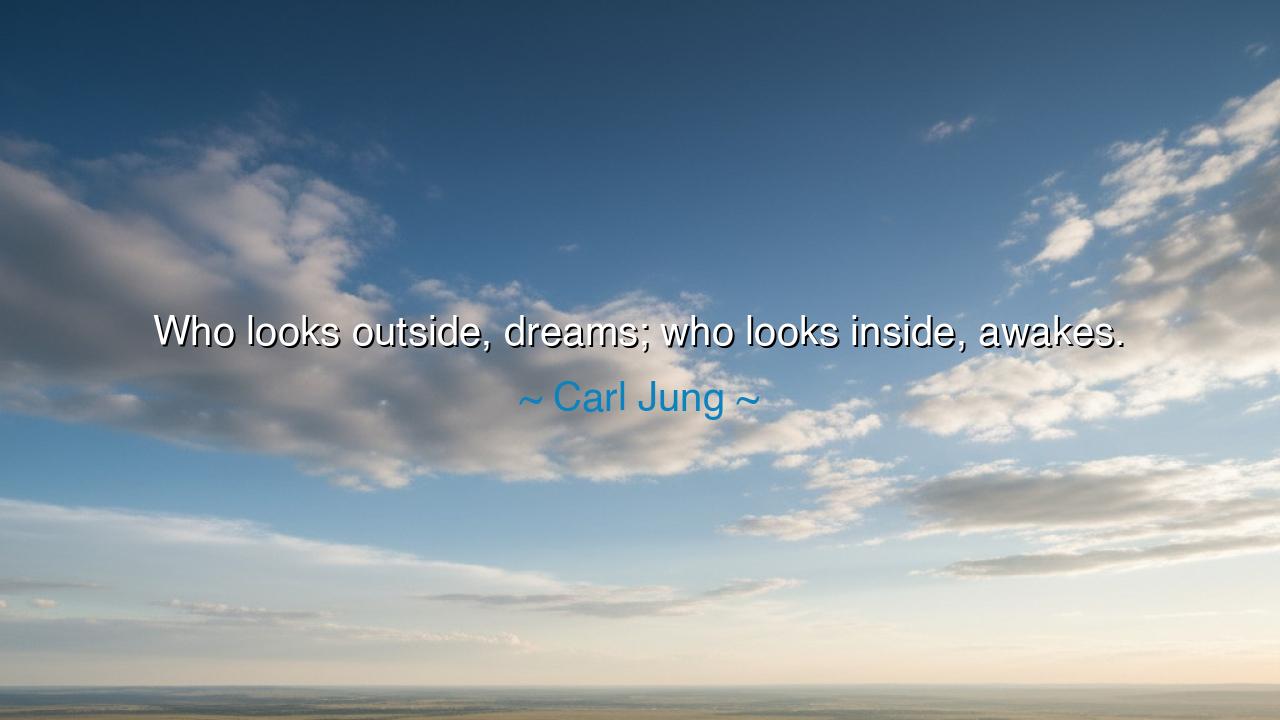
Who looks outside, dreams; who looks inside, awakes.






When the great mystic and psychologist Carl Jung declared, “Who looks outside, dreams; who looks inside, awakes,” he gave voice to one of the oldest truths known to humankind—the call to self-knowledge. His words are not merely poetic; they are a summons from the depths of the soul. Jung, who walked the twilight between science and spirit, knew that the outer world, though dazzling and vast, is but a reflection of the inner one. To look outside is to wander among illusions; to look inside is to find reality. For the eyes that turn inward pierce through the veil of appearances and behold the eternal self.
In his time, Jung stood at the crossroads of modern reason and ancient wisdom. He studied the mind as one might study the stars—tracing its patterns, its symbols, its shadows. Through his work, he rediscovered what the ancients had long taught: that true awakening begins not with the conquest of the world, but with the conquest of the self. The dream of the outer world—its pleasures, ambitions, and endless distractions—can lull the spirit into forgetfulness. But when one turns inward, facing both the light and darkness within, one begins the sacred journey toward wholeness. To awake, as Jung said, is to become conscious—not only of the world, but of the divine spark that sleeps within every human being.
To look outside is easy. The world invites us with its noise and glitter. We chase its rewards—status, wealth, admiration—and call these things success. Yet they are but shadows cast upon the cave wall of existence. The dreamer, enchanted by what he sees, believes the dream to be real. But when he turns away from the flickering light and walks into the darkness of his own heart, he begins to see truly. The outer dream dissolves, and in its place rises the clear, unyielding truth of what he is—and what he must become. The act of looking inside is not an escape from life, but a return to its source.
Consider the journey of Prince Siddhartha, who later became the Buddha. Surrounded by luxury, he lived a life of endless dreams—a world crafted to shield him from suffering and imperfection. But one day, he saw age, sickness, and death, and his illusions shattered. He turned away from the palace, from the outside, and sought the truth within. Under the Bodhi tree, in the stillness of his own being, he awoke. What he discovered there was not an answer given by the world, but a truth born of the soul. Thus, his story, like Jung’s teaching, reveals that awakening comes only when we cease to seek fulfillment beyond ourselves.
The meaning of Jung’s words is therefore both psychological and spiritual. He reminds us that the outer world is transient—it changes with fortune, with time, with perception. But the inner world, though hidden, is eternal. To live by what is outside is to live in constant dream, tossed by the winds of circumstance. To live by what is within is to stand upon solid ground, guided by the quiet voice of the soul. The one who looks within confronts both light and shadow, joy and sorrow, the noble and the base—but in that confrontation, he becomes whole. This is the true awakening Jung speaks of: the integration of all that we are, so that we no longer drift through life asleep, but walk through it conscious and free.
In every age, there are those who awaken and those who sleep. The sleepers chase images of happiness, mistaking reflection for reality. The awakened walk among them quietly, their eyes clear, their hearts steady. They are not swayed by the praise or scorn of others, for they draw strength from an inner fountain that cannot run dry. The ancient oracle of Delphi bore the same truth in its command: “Know thyself.” For to know oneself is to awaken from the world’s dream, and to see with the vision of the soul.
The lesson, my child, is this: do not seek your truth in the faces or approval of others. Do not measure your worth by the shifting tides of the outer world. Turn your gaze inward. Ask yourself who you are when the world grows silent. Sit with your thoughts, your fears, your desires, until they reveal their meaning. Let self-knowledge be your compass, and awareness your crown. For only the one who dares to look within can truly awake, and only the awakened can live with purpose, peace, and power.
So, when the world tempts you with its noise and glory, remember Jung’s eternal wisdom: *“Who looks outside, dreams; who looks inside, *awakes.” Do not fear the silence within you—it is not emptiness, but the birthplace of light. Close your eyes to the world for a time, and you will see farther than the horizon. The greatest journey is not across oceans or stars, but into the heart of your own being. There, in that sacred stillness, the dream ends—and the true life begins.






AAdministratorAdministrator
Welcome, honored guests. Please leave a comment, we will respond soon